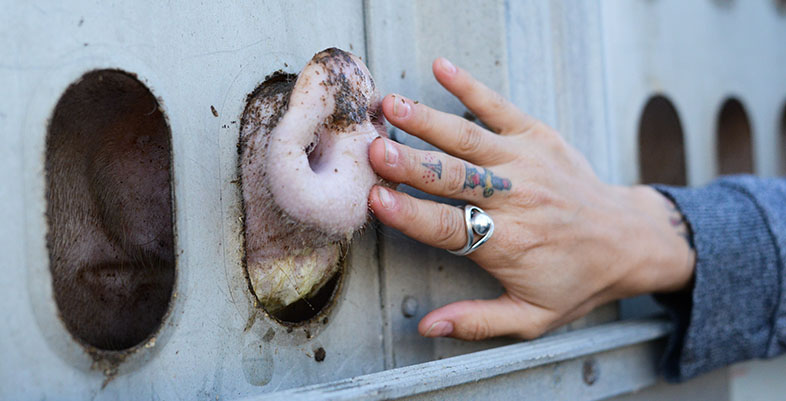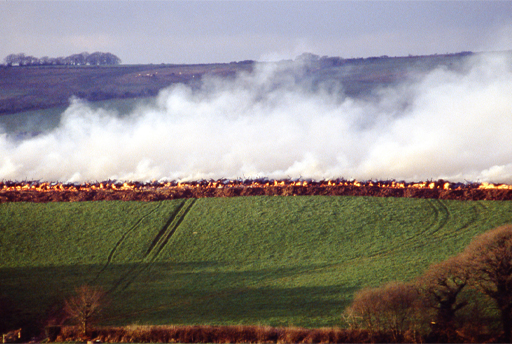2.1 ‘Livestock’ farming, fishing and social harm
Professor of Communication, Núria Almiron argues that ‘the exploitation of billions of nonhuman animals for food, has always been, and particularly is today, among the most profitable businesses on earth’ (2016, p. 28). The scale of these profits relates to the numbers of ‘livestock’ bred and killed.
Box 1 The big picture – ‘livestock’ and aquatic animals
‘Livestock’ animals
- Three times more ‘livestock’ animals than humans are alive at any given time. This includes 19 billion chickens, 1.5 billion cows, 1 billion pigs and 1 billion sheeps, according to the United Nations Food and Agriculture Organisation (UNFAO) (Economic Forum, 2019).
- 70 billion ‘livestock’ animals are slaughtered for human food globally each year; around 50 billion of them are chickens (Faunalytics, 2018).
Aquatic animals
- Precise numbers of aquatic animals killed for human consumption are unrecorded, but even low estimates dwarf the figures for the killing of land-dwelling ‘livestock’ animals.
- 790–2300 billion free-living fishes were caught for human consumption during the decade 2007–16 according to UNFAO (FishCount, 2019).
- In 2015 alone aquaculture (colloquially called ‘fish farming’) accounted for the killing of 48–160 billion fishes and 220–520 billion crustaceans (Fish Count, 2019).
Different jurisdictions have different laws governing legally permissible harming of farmed animals, but all ‘livestock’ farming necessitates killing. This is obviously so for ‘meat’, but also applies to killing ‘dairy’ cows and laying hens when they are no longer able to produce enough milk or eggs to be profitably kept alive. These harms include slaughterhouse killing but also legal killing on farms in certain cases of serious injury or infectious disease, such as foot and mouth. These deaths are not included in the 70 billion ‘livestock’ animals slaughtered annually cited by Faunalytics (2018).
In the dairy industry, some male calves live for a few months before being killed to produce ‘veal’, but many are killed on farms soon after birth, because they are not profitable if raised to provide ‘beef ’. These cows have not been selectively bred to gain weight in the form of saleable flesh, so the male calves do not provide an economic return on the costs of raising them to maturity. In the egg industry, male chicks are also killed soon after hatching. It is unprofitable to raise them for their flesh, because of selective breeding that favours the egg-laying capacity of hens above all. Some of the legal harms other than killing in ‘livestock’ farming are described by Hunt (2015) and Masson (2009):
- confinement of some species of nonhuman animals in cages (such as those used for egg-laying hens and other birds), stalls, or barns, which restrict bodily movement and may cause physical and/or mental distress
- enforced body modifications, such as the amputation of pigs’ tails, the ‘clipping’ of piglets’ teeth, the castration of piglets or the partial amputation of hens’ beaks (sometimes called ‘debeaking’)
- increased incidence of injury or infections resulting from the farm environment, such as mastitis (a painful inflammation of cows’ udders)
- forced insemination of female ‘livestock’ animals, such as ‘dairy’ cows who are kept in a perpetual cycle of pregnancy and lactation until physically unable to produce milk at profitable levels
- separation of kin, such as the removal of calves from their mothers in the dairy industry so that the milk can be appropriated for human use, or the removal of lambs from their mothers to be slaughtered for ‘meat’.
Different jurisdictions regulate to limit some of these harms to different extents, but harm is ubiquitous in all forms of ‘livestock’ farming and harms such as separation of kin are inevitable in order to obtain other animals’ milk, or the flesh of young mammals. These harms are not limited to physical injury or death, but also include mental and emotional distress. ‘Livestock’ farming is also associated with significant environmental harms that impact on free-living nonhuman animals (Hunt, 2015).

